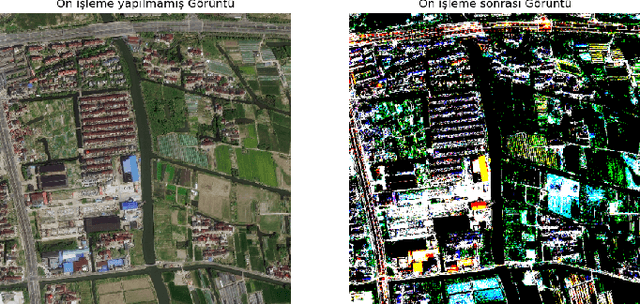Metehan Yalçın
Building Segmentation on Satellite Images and Performance of Post-Processing Methods
Dec 28, 2022



Abstract:Researchers are doing intensive work on satellite images due to the information it contains with the development of computer vision algorithms and the ease of accessibility to satellite images. Building segmentation of satellite images can be used for many potential applications such as city, agricultural, and communication network planning. However, since no dataset exists for every region, the model trained in a region must gain generality. In this study, we trained several models in China and post-processing work was done on the best model selected among them. These models are evaluated in the Chicago region of the INRIA dataset. As can be seen from the results, although state-of-art results in this area have not been achieved, the results are promising. We aim to present our initial experimental results of a building segmentation from satellite images in this study.
Semi-Supervised Domain Adaptation for Semantic Segmentation of Roads from Satellite Images
Dec 26, 2022Abstract:This paper presents the preliminary findings of a semi-supervised segmentation method for extracting roads from sattelite images. Artificial Neural Networks and image segmentation methods are among the most successful methods for extracting road data from satellite images. However, these models require large amounts of training data from different regions to achieve high accuracy rates. In cases where this data needs to be of more quantity or quality, it is a standard method to train deep neural networks by transferring knowledge from annotated data obtained from different sources. This study proposes a method that performs path segmentation with semi-supervised learning methods. A semi-supervised field adaptation method based on pseudo-labeling and Minimum Class Confusion method has been proposed, and it has been observed to increase performance in targeted datasets.
Minimum Class Confusion based Transfer for Land Cover Segmentation in Rural and Urban Regions
Dec 05, 2022Abstract:Transfer Learning methods are widely used in satellite image segmentation problems and improve performance upon classical supervised learning methods. In this study, we present a semantic segmentation method that allows us to make land cover maps by using transfer learning methods. We compare models trained in low-resolution images with insufficient data for the targeted region or zoom level. In order to boost performance on target data we experiment with models trained with unsupervised, semi-supervised and supervised transfer learning approaches, including satellite images from public datasets and other unlabeled sources. According to experimental results, transfer learning improves segmentation performance 3.4% MIoU (Mean Intersection over Union) in rural regions and 12.9% MIoU in urban regions. We observed that transfer learning is more effective when two datasets share a comparable zoom level and are labeled with identical rules; otherwise, semi-supervised learning is more effective by using the data as unlabeled. In addition, experiments showed that HRNet outperformed building segmentation approaches in multi-class segmentation.
 Add to Chrome
Add to Chrome Add to Firefox
Add to Firefox Add to Edge
Add to Edge